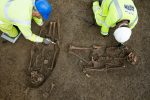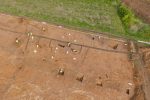 An archaeological survey along the route of a highway expansion project in Cambridgeshire, England, has unearthed the skeletal remains of two men with an unusual mutilation and burial. The bones date to the late Roman or early Anglo-Saxon period. Their legs were cut off at the knees and repositioned by their shoulders. It’s not clear whether the amputations were done pre-, peri- or post-mortem, but initial analysis suggests the severed legs were still fleshed, at least partially, before they were placed at the shoulders.
An archaeological survey along the route of a highway expansion project in Cambridgeshire, England, has unearthed the skeletal remains of two men with an unusual mutilation and burial. The bones date to the late Roman or early Anglo-Saxon period. Their legs were cut off at the knees and repositioned by their shoulders. It’s not clear whether the amputations were done pre-, peri- or post-mortem, but initial analysis suggests the severed legs were still fleshed, at least partially, before they were placed at the shoulders.
The two bodies were buried at right angles to each other in a T-shape with their heads facing outwards. They were not laid to rest in a formal burial ground; they were interred in a gravel pit.
The best scenario the archaeologists can hope for is that the unfortunate men were dead when their legs were mutilated. It also appears their skulls were smashed in, although that could be later damage.
“Was it to keep them in their graves and stop them from running away?” said Kasia Gdaniec, the senior archaeologist with Cambridge county council. “Or had they tried to run away and was this a punishment – and a warning to everyone else not even to think of it?”
The bones (crushed skulls excepted) are in good condition and even with a smashed skull one of them has an excellent set of teeth. DNA analysis, stable isotope analysis and radiocarbon dating should therefore be possible which will narrow down when the individuals died, their sexes, where they were raised and a number of other details about them.
 The unusual burials were discovered in one of the largest excavation projects in UK history. Teams have excavated 40 sites over 350 hectares where the A14 Cambridge to Huntingdon is being widened to alleviate congestion. Archaeologists have found a wide array of remains of Bronze Age barrows to medieval towns, but the Roman finds are of particular note, illustrating the progress of occupation, how the landscape and population were bent to the Roman will.
The unusual burials were discovered in one of the largest excavation projects in UK history. Teams have excavated 40 sites over 350 hectares where the A14 Cambridge to Huntingdon is being widened to alleviate congestion. Archaeologists have found a wide array of remains of Bronze Age barrows to medieval towns, but the Roman finds are of particular note, illustrating the progress of occupation, how the landscape and population were bent to the Roman will.
Gdaniec finds the whole site quite sinister. “People talk about the archaeology of conquest, but I have never felt it as strongly as here. The Romans arrive, the people who were here are completely subjugated, everything changes and is never the same again. We are not seeing trade and peaceful co-existence here, we are seeing enslavement.”
The site had been enclosed by a rather wiggly ditch, more a windbreak than either seriously defensive or a statement of power. The Romans then arrived and by stupendous effort drove a huge ditch across it, almost two metres deep and three wide with the spoil heaped up into a huge bank. Despite its size and the labour involved, there was no evidence of large permanent Roman buildings and so the archaeologists believe it was a temporary camp on the march north towards Hadrian’s Wall.
Within the new enclosure, farming became much more organised and intensive, with wheat and other cereals, beans and root crops being grown. […]
The site has also produced scores of pottery kilns, some so tiny the archaeologists joked they must have been for egg cups, others large and sophisticated, producing domestic and storage pottery on an industrial scale. Tonnes of pottery were found along the excavation sites.
“We have some of the pottery they produced,” House said. “It will be interesting to see if we can match it to pottery from other Roman sites. I wouldn’t be surprised if some of the pots from this field ended up on Hadrian’s Wall.”